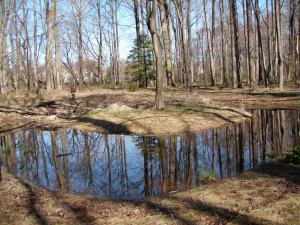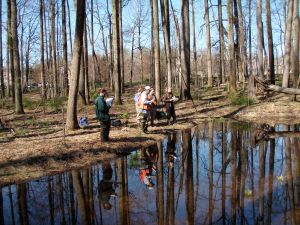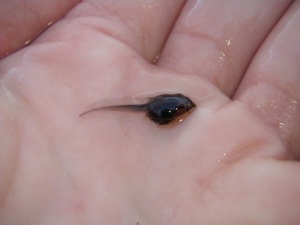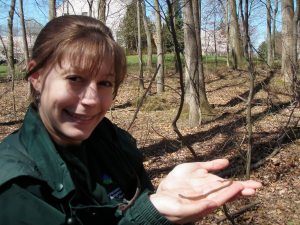Restoration monitoring is one of our main jobs as County aquatic biologists. Following stream restoration, where the shape, channel, and habitat of a stream has been historically damaged (usually by destructively fast-flowing stormwater in urban areas), we monitor the site to assess whether the restoration efforts have been effective in reaching their stated goals (which can include: whether biological life is thriving again, and whether stream life is recovering).
The project we visited today is in the Rock Creek watershed. As part of the restoration, wetlands were artificially constructed into the stream’s floodplains. This is critical habitat for frogs, salamanders, and toads, particularly in their reproduction phase.

A man-made wetland pool at a stream restoration site in Gaithersburg
Although stream conditions in the Upper Rock Creek watershed tend to be good to excellent, the Stream Valley Drive tributary was suffering from development impacts resulting from historic agricultural practices, a power line crossing, and road crossings. These impacts caused the stream to experience increased stormwater flows, erosion, high sedimentation, incised channels, and degraded stream habitat. Important forest and floodplain habitat was also lost.
We visited the site to evaluate one of the man-made wetland pools, assess stream habitat, and collect a benthic macroinvertebrate sample to use as an indicator of water quality. This is the last time this site will be monitored and it marks the fifth year following restoration activities.

Environmental scientists gathering data from the edge of the restored, created wetland.
The man-made wetland pool we were monitoring was alive with activity! Before arriving at the pool, we could hear the calls of northern spring peepers! We also heard several calling birds: downy, red-bellied, and pileated woodpeckers, Carolina wren, and tufted titmouse, among others. We even caught a glimpse of the red-bellied and pileated woodpeckers actively in search of food amongst the treetops.
Once at the pool, we began collecting data on the conditions of the pool and the animals and plants associated with it. The first thing noticed were over a thousand tadpoles throughout the pool – and we were thrilled!

Underwater shot of the tadpoles in the man-made wetland pool captured by Jenny. How neat is it to see the tadpoles schooling like fish for protection?
We captured a few of the tadpoles to confirm what species were present in the pool. The representatives we caught were all toad tadpoles.

A closer view of one of many tadpoles observed at the restoration site. Although tiny, we could tell it was a toad tadpole based on the body, coloration, and tail shape.
While examining the wetland pool we also found several spotted salamander egg masses! It is a great sign to see that this pool is being utilized by this very sensitive species. Spotted salamanders require seasonal pools for successful breeding, and the pools must have good water quality and remain wet long enough for the larvae to develop. Additionally, the adults retreat to upland forested habitat following breeding so this component must be present as well. Spotted salamander egg masses have been observed every year of monitoring following construction of the wetland pool, telling us that installation of this particular pool was successful. We did not take any pictures of the egg masses at this site because they were too far from the water’s edge to capture a clear photograph. We wanted to minimize disturbance to the pool so we did not enter it.
As we continued to examine the pool, we got on our hands and knees and peered closer into the pool and found many invertebrates that told us the pool is doing well – copepods, predaceous diving beetles, and water striders. These invertebrates were too quick and small to get a picture of this time!
In addition to examining the pool itself, we looked at the area surrounding the pool. The majority of the trees and other vegetation appeared to be fairing well.

A tree planted as part of the restoration at the Stream Valley Drive Project. The tube at its base stabilizes it and protects it from hungry deer and other wildlife
As part of our assessment, we also searched for adult amphibians and reptiles around the pool’s edge by looking under cover objects such as logs and rocks. In doing so, we found another treat – a young northern brownsnake!

The northern brownsnake we caught was just as interested in observing us as we were in it. Its tongue was constantly flicking to pick up smells and gather information while Rachel snapped pictures.
Northern brownsnakes are a fairly common species of snake that feed primarily on earthworms. This species is very docile and does not bite when captured. They also very rarely musk (release a foul smell from their cloaca), so they are great ambassadors to folks who may be leery of snakes. Although relatively common, we do not encounter them very frequently and were excited to see another animal contributing to the biodiversity of the site and using the restored habitat.

Rachel examining her catch -- a young brownsnake

Jennifer St. John with a brown snake
SHARE THIS STORY ON SOCIAL MEDIA:



















